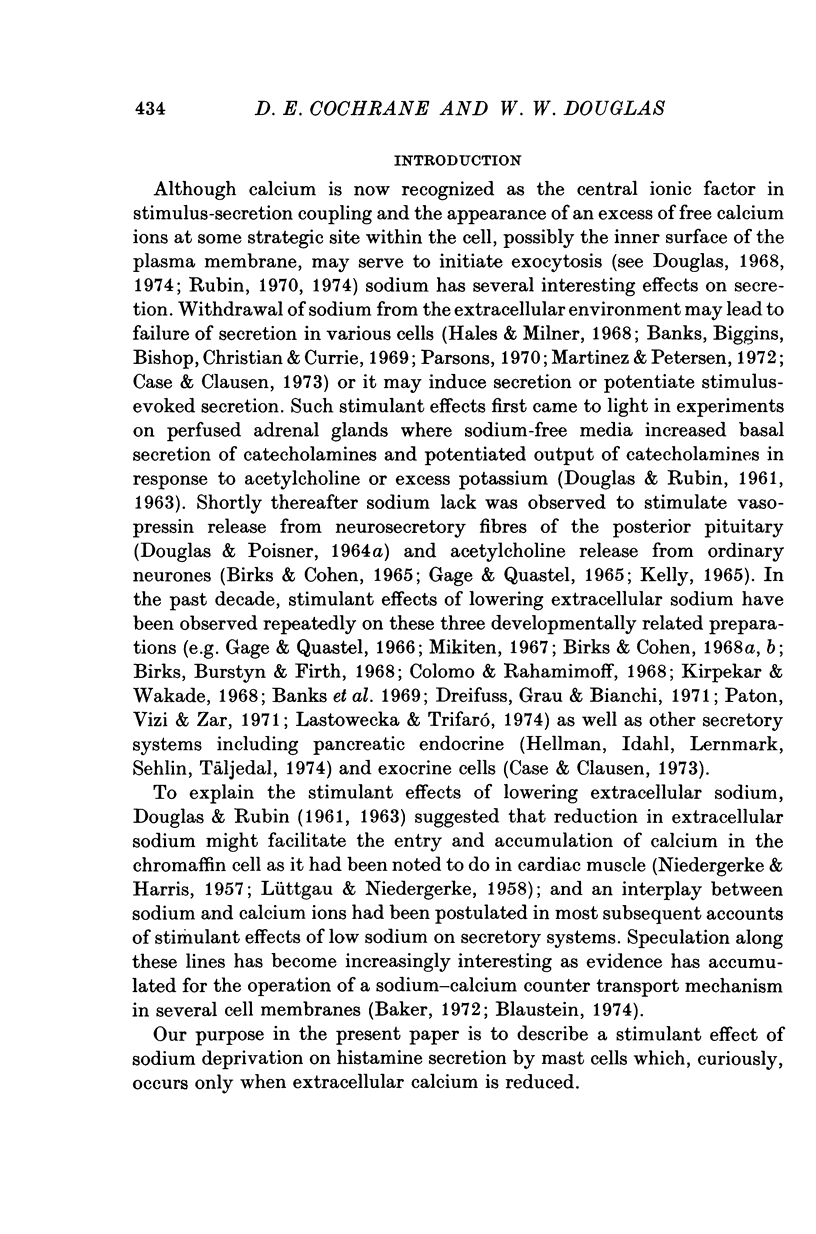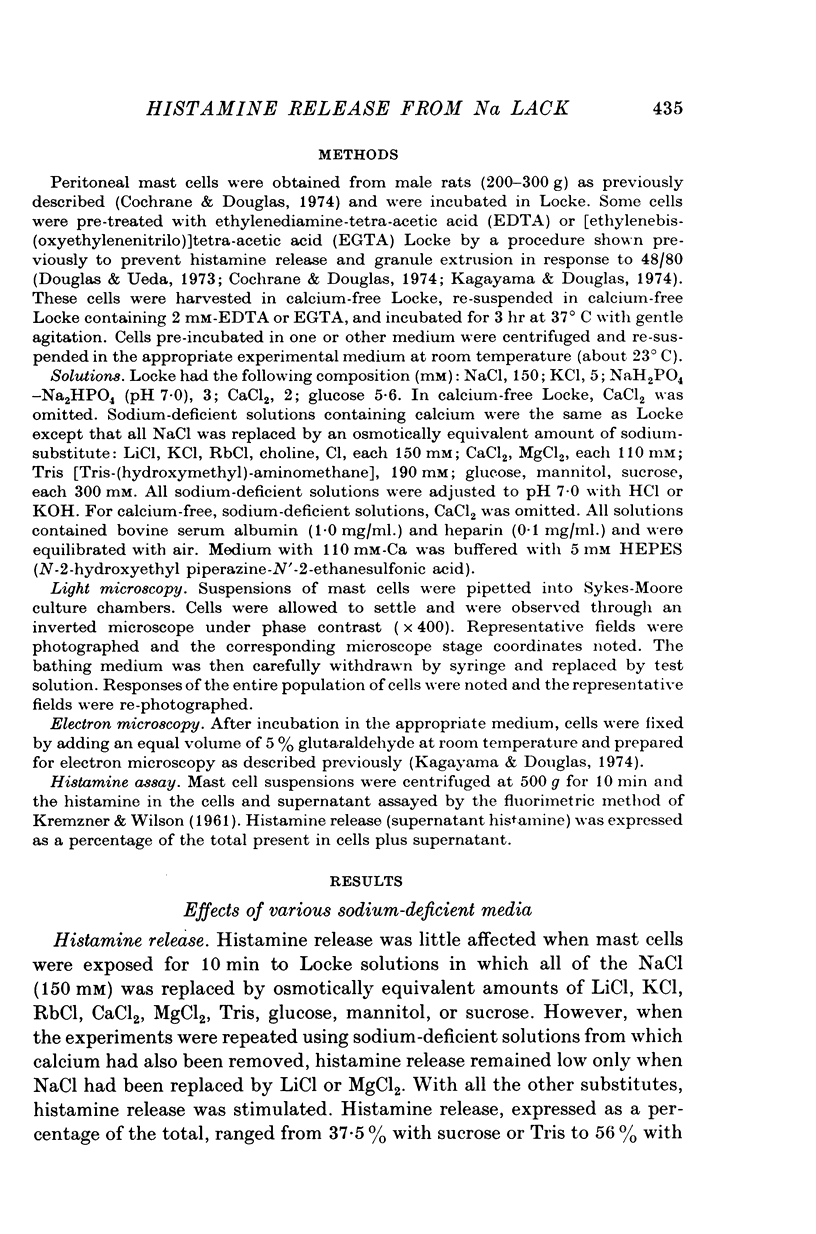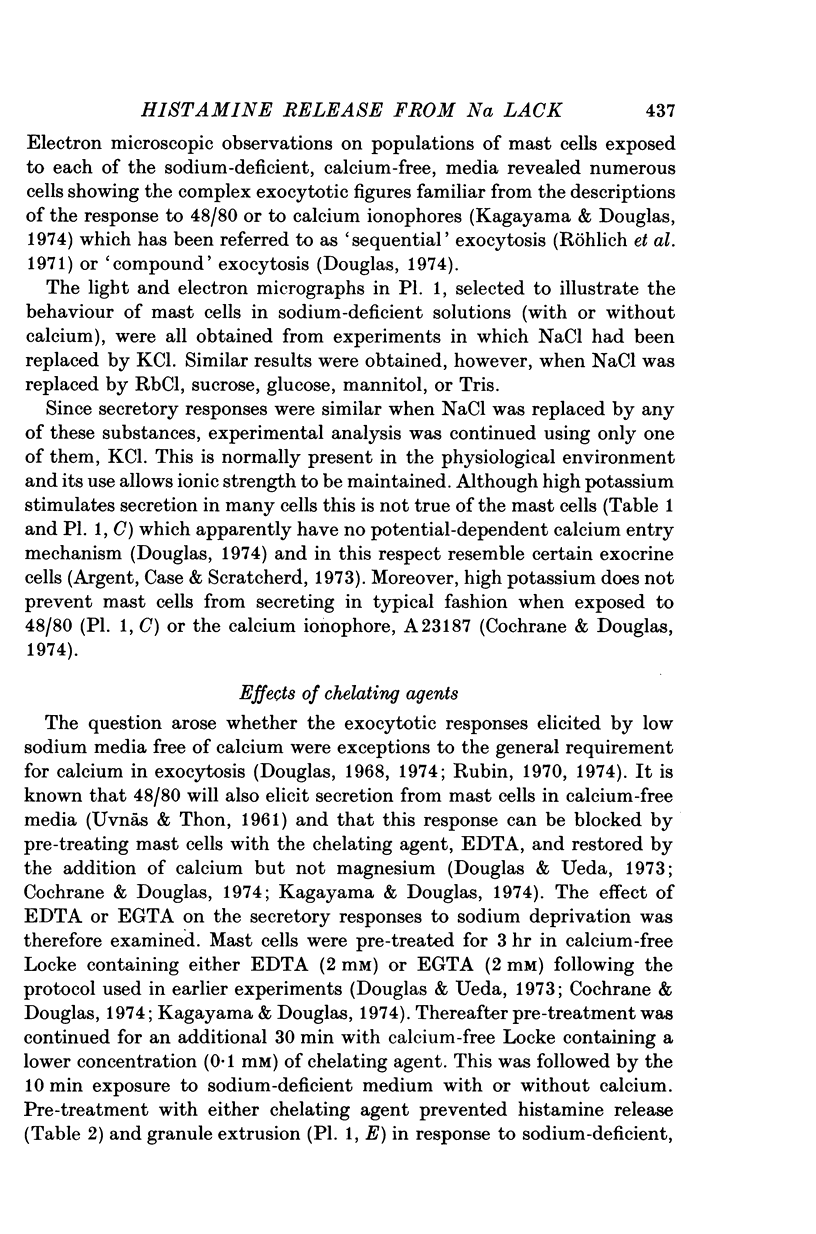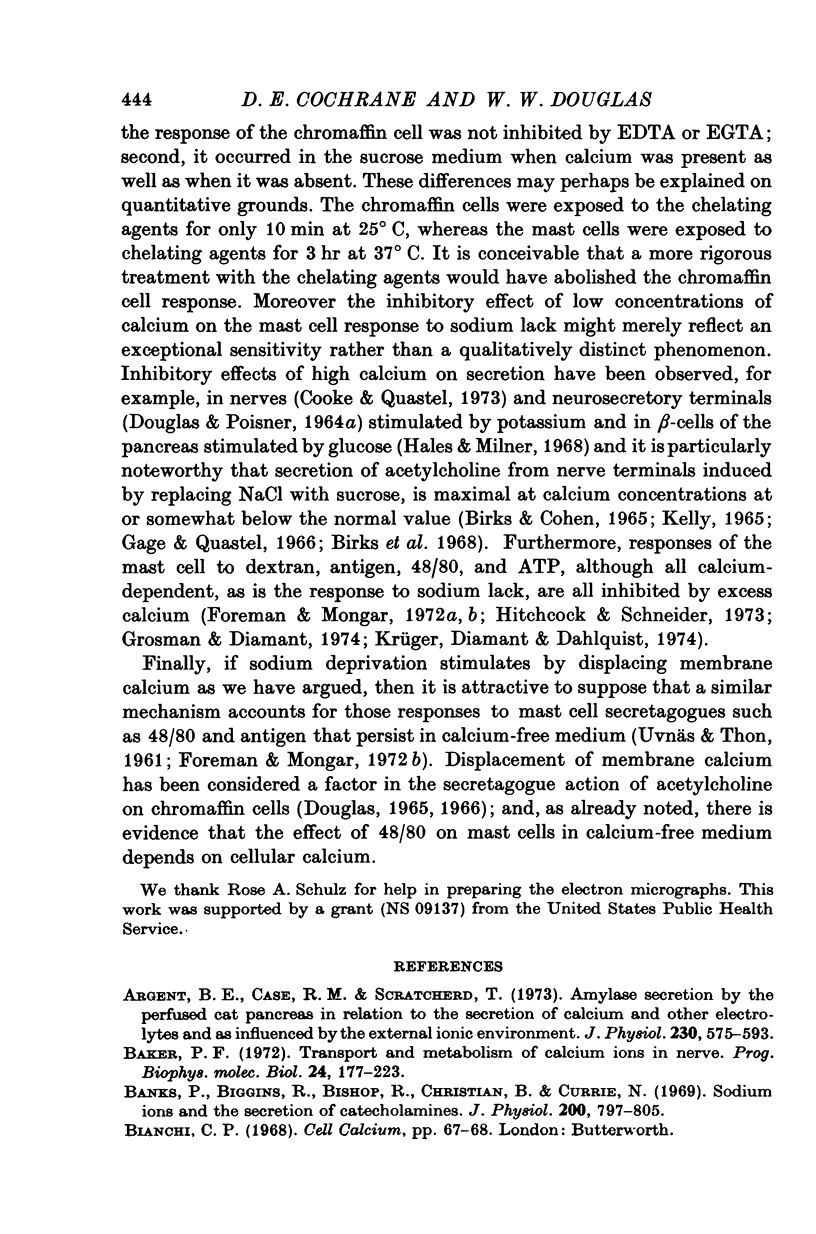Abstract
1. Histamine release from peritoneal mast cells of the rat was stimulated when the cells were exposed for 10 min to sodium-deficient media where all NaCl had been replaced by KC1, RbC1, glucose, sucrose, mannitol, or Tris, provided calcium was less than about 0-5 mM. 2. Light and electron microscopy showed the response to be exocytosis. 3. The chelating agents, EDTA and EGTA, abolished the response to sodium lack and their inhibitory effects were reversed by re-incubating cells with calcium but not magnesium. 4. The response was inhibited by dinitrophenol combined with glucose-deprivation. 5. The response was inversely related to the concentrations of sodium and calcium below 137-5 and 0-5 mM respectively. 6. The related alkaline earth metals, barium, strontium, and magnesium, resembled calcium in inhibiting the response to sodium lack. 7. No secretory response was seen when the cells were exposed for 10 min to calcium-free medium in which lithium replaced sodium. Exposure to this medium for 60 min, however, elicited secretion. 8. It is concluded that when extracellular calcium is low, a reduction in extracellular sodium induces a conventional exocytotic secretory response dependent on energy and cellular calcium. It is suggested that sodium lack may mobilize calcium from a cellular site possibly the inner aspect of the plasma membrane.
Full text
PDF
















Images in this article
Selected References
These references are in PubMed. This may not be the complete list of references from this article.
- Argent B. E., Case R. M., Scratcherd T. Amylase secretion by the perfused cat pancreas in relation to the secretion of calcium and other electrolytes and as influenced by the external ionic environment. J Physiol. 1973 May;230(3):575–593. doi: 10.1113/jphysiol.1973.sp010205. [DOI] [PMC free article] [PubMed] [Google Scholar]
- Banks P., Biggins R., Bishop R., Christian B., Currie N. Sodium ions and the secretion of catecholamines. J Physiol. 1969 Feb;200(3):797–805. doi: 10.1113/jphysiol.1969.sp008722. [DOI] [PMC free article] [PubMed] [Google Scholar]
- Birks R. I., Burstyn P. G., Firth D. R. The form of sodium-calcium competition at the frog myoneural junction. J Gen Physiol. 1968 Dec;52(6):887–907. doi: 10.1085/jgp.52.6.887. [DOI] [PMC free article] [PubMed] [Google Scholar]
- Birks R. I., Cohen M. W. The action of sodium pump inhibitors on neuromuscular transmission. Proc R Soc Lond B Biol Sci. 1968 Jul 9;170(1021):381–399. doi: 10.1098/rspb.1968.0046. [DOI] [PubMed] [Google Scholar]
- Birks R. I., Cohen M. W. The influence of internal sodium on the behaviour of motor nerve endings. Proc R Soc Lond B Biol Sci. 1968 Jul 9;170(1021):401–421. doi: 10.1098/rspb.1968.0047. [DOI] [PubMed] [Google Scholar]
- Blaustein M. P. The interrelationship between sodium and calcium fluxes across cell membranes. Rev Physiol Biochem Pharmacol. 1974;70:33–82. doi: 10.1007/BFb0034293. [DOI] [PubMed] [Google Scholar]
- Bloom G. D., Haegermark O. A study on morphological changes and histamine release induced by compound 48/80 in rat peritoneal mast cells. Exp Cell Res. 1965 Dec;40(3):637–654. doi: 10.1016/0014-4827(65)90241-7. [DOI] [PubMed] [Google Scholar]
- Carmody J. J., Gage P. W. Lithium stimulates secretion of acetylcholine in the absence of extracellular calcium. Brain Res. 1973 Feb 28;50(2):476–479. doi: 10.1016/0006-8993(73)90755-5. [DOI] [PubMed] [Google Scholar]
- Case R. M., Clausen T. The relationship between calcium exchange and enzyme secretion in the isolated rat pancreas. J Physiol. 1973 Nov;235(1):75–102. doi: 10.1113/jphysiol.1973.sp010379. [DOI] [PMC free article] [PubMed] [Google Scholar]
- Cochrane D. E., Douglas W. W. Calcium-induced extrusion of secretory granules (exocytosis) in mast cells exposed to 48-80 or the ionophores A-23187 and X-537A. Proc Natl Acad Sci U S A. 1974 Feb;71(2):408–412. doi: 10.1073/pnas.71.2.408. [DOI] [PMC free article] [PubMed] [Google Scholar]
- Colomo F., Rahamimoff R. Interaction between sodium and calcium ions in the process of transmitter release at the neuromuscular junction. J Physiol. 1968 Sep;198(1):203–218. doi: 10.1113/jphysiol.1968.sp008602. [DOI] [PMC free article] [PubMed] [Google Scholar]
- Cooke J. D., Okamoto K., Quastel D. M. The role of calcium in depolarization-secretion coupling at the motor nerve terminal. J Physiol. 1973 Jan;228(2):459–497. doi: 10.1113/jphysiol.1973.sp010095. [DOI] [PMC free article] [PubMed] [Google Scholar]
- Cooke J. D., Quastel D. M. The specific effect of potassium on transmitter release by motor nerve terminals and its inhibition by calcium. J Physiol. 1973 Jan;228(2):435–458. doi: 10.1113/jphysiol.1973.sp010094. [DOI] [PMC free article] [PubMed] [Google Scholar]
- Crawford A. C. Lithium ions and the release of transmitter at the frog neuromuscular junction. J Physiol. 1975 Mar;246(1):109–142. doi: 10.1113/jphysiol.1975.sp010882. [DOI] [PMC free article] [PubMed] [Google Scholar]
- DOUGLAS W. W., POISNER A. M. CALCIUM MOVEMENT IN THE NEUROHYPOPHYSIS OF THE RAT AND ITS RELATION TO THE RELEASE OF VASOPRESSIN. J Physiol. 1964 Jul;172:19–30. doi: 10.1113/jphysiol.1964.sp007400. [DOI] [PMC free article] [PubMed] [Google Scholar]
- DOUGLAS W. W., POISNER A. M. STIMULUS-SECRETION COUPLING IN A NEUROSECRETORY ORGAN: THE ROLE OF CALCIUM IN THE RELEASE OF VASOPRESSIN FROM THE NEUROHYPOPHYSIS. J Physiol. 1964 Jul;172:1–18. doi: 10.1113/jphysiol.1964.sp007399. [DOI] [PMC free article] [PubMed] [Google Scholar]
- DOUGLAS W. W., RUBIN R. P. The role of calcium in the secretory response of the adrenal medulla to acetylcholine. J Physiol. 1961 Nov;159:40–57. doi: 10.1113/jphysiol.1961.sp006791. [DOI] [PMC free article] [PubMed] [Google Scholar]
- Douglas W. W. Involvement of calcium in exocytosis and the exocytosis--vesiculation sequence. Biochem Soc Symp. 1974;(39):1–28. [PubMed] [Google Scholar]
- Douglas W. W., Rubin R. P. The mechanism of catecholamine release from the adrenal medulla and the role of calcium in stimulus-secretion coupling. J Physiol. 1963 Jul;167(2):288–310. doi: 10.1113/jphysiol.1963.sp007150. [DOI] [PMC free article] [PubMed] [Google Scholar]
- Douglas W. W. Stimulus-secretion coupling: the concept and clues from chromaffin and other cells. Br J Pharmacol. 1968 Nov;34(3):451–474. doi: 10.1111/j.1476-5381.1968.tb08474.x. [DOI] [PMC free article] [PubMed] [Google Scholar]
- Foreman J. C., Mongar J. L., Gomperts B. D. Calcium ionophores and movement of calcium ions following the physiological stimulus to a secretory process. Nature. 1973 Oct 5;245(5423):249–251. doi: 10.1038/245249a0. [DOI] [PubMed] [Google Scholar]
- Foreman J. C., Mongar J. L. The role of the alkaline earth ions in anaphylactic histamine secretion. J Physiol. 1972 Aug;224(3):753–769. doi: 10.1113/jphysiol.1972.sp009921. [DOI] [PMC free article] [PubMed] [Google Scholar]
- Gage P. W., Quastel D. M. Competition between sodium and calcium ions in transmitter release at mammalian neuromuscular junctions. J Physiol. 1966 Jul;185(1):95–123. doi: 10.1113/jphysiol.1966.sp007974. [DOI] [PMC free article] [PubMed] [Google Scholar]
- Gage P. W., Quastel D. M. Influence of sodium ions on transmitter release. Nature. 1965 Jun 5;206(988):1047–1048. doi: 10.1038/2061047a0. [DOI] [PubMed] [Google Scholar]
- Grosman N., Diamant B. Studies on the role of calcium in the anaphylactic histamine release from isolated rat mast cells. Acta Pharmacol Toxicol (Copenh) 1974 Oct;35(4):284–292. doi: 10.1111/j.1600-0773.1974.tb00748.x. [DOI] [PubMed] [Google Scholar]
- Hellman B., Idahl L. A., Lernmark A., Sehlin J., Täljedal I. B. The pancreatic beta-cell recognition of insulin secretagogues. Effects of calcium and sodium on glucose metabolism and insulin release. Biochem J. 1974 Jan;138(1):33–45. doi: 10.1042/bj1380033. [DOI] [PMC free article] [PubMed] [Google Scholar]
- Hitchcock M., Schneider M. W. Effect of calcium and temperature on histamine release from pig lung by compound 48-80. Experientia. 1973 Nov 15;29(11):1369–1370. doi: 10.1007/BF01922824. [DOI] [PubMed] [Google Scholar]
- Horsfield G. I. The effect of compound 48/80 on the rat mast cell. J Pathol Bacteriol. 1965 Oct;90(2):599–605. doi: 10.1002/path.1700900228. [DOI] [PubMed] [Google Scholar]
- KELLY J. S. ANTAGONISM BETWEEN NA+ AND CA2+ AT THE NEUROMUSCULAR JUNCTION. Nature. 1965 Jan 16;205:296–297. doi: 10.1038/205296a0. [DOI] [PubMed] [Google Scholar]
- Kagayama M., Douglas W. W. Electron microscope evidence of calcium-induced exocytosis in mast cells treated with 48-80 or the ionophores A-23187 and X-537A. J Cell Biol. 1974 Aug;62(2):519–526. doi: 10.1083/jcb.62.2.519. [DOI] [PMC free article] [PubMed] [Google Scholar]
- Kanno T., Cochrane D. E., Douglas W. W. Exocytosis (secretory granule extrusion) induced by injection of calcium into mast cells. Can J Physiol Pharmacol. 1973 Dec;51(12):1001–1004. doi: 10.1139/y73-153. [DOI] [PubMed] [Google Scholar]
- Kelly J. S. The antagonism of Ca2+ by Na+ and other monovalent ions at the frog neuromuscular junction. Q J Exp Physiol Cogn Med Sci. 1968 Jul;53(3):239–249. doi: 10.1113/expphysiol.1968.sp001967. [DOI] [PubMed] [Google Scholar]
- Kirpekar S. M., Wakade A. R. Release of noradrenaline from the cat spleen by potassium. J Physiol. 1968 Feb;194(3):595–608. doi: 10.1113/jphysiol.1968.sp008427. [DOI] [PMC free article] [PubMed] [Google Scholar]
- Krüger P. G., Diamant B., Dahlquist R. Morphological changes induced by ATP on rat mast cells and their relationship to histamine release. Int Arch Allergy Appl Immunol. 1974;46(5):676–688. doi: 10.1159/000231168. [DOI] [PubMed] [Google Scholar]
- Lagunoff D. Membrane fusion during mast cell secretion. J Cell Biol. 1973 Apr;57(1):252–259. doi: 10.1083/jcb.57.1.252. [DOI] [PMC free article] [PubMed] [Google Scholar]
- Lastowecka A., Trifaró J. M. The effect of sodium and calcium ions on the release of catecholamines from the adrenal medulla: sodium deprivation induces release by exocytosis in the absence of extracellular calcium. J Physiol. 1974 Feb;236(3):681–705. doi: 10.1113/jphysiol.1974.sp010460. [DOI] [PMC free article] [PubMed] [Google Scholar]
- MONGAR J. L., SCHILD H. O. The effect of calcium and pH on the anaphylactic reaction. J Physiol. 1958 Feb 17;140(2):272–284. doi: 10.1113/jphysiol.1958.sp005933. [DOI] [PMC free article] [PubMed] [Google Scholar]
- Martinez J. R., Petersen O. H. The importance of extracellular calcium for acetylcholine-evoked salivary secretion. Experientia. 1972 Feb 15;28(2):167–168. doi: 10.1007/BF01935735. [DOI] [PubMed] [Google Scholar]
- NIEDERGERKE R., HARRIS E. J. Accumulation of calcium (or strontium) under conditions of increasing contractility. Nature. 1957 May 25;179(4569):1068–1069. doi: 10.1038/1791068a0. [DOI] [PubMed] [Google Scholar]
- Paton W. D., Vizi E. S., Zar M. A. The mechanism of acetylcholine release from parasympathetic nerves. J Physiol. 1971 Jul;215(3):819–848. doi: 10.1113/jphysiol.1971.sp009500. [DOI] [PMC free article] [PubMed] [Google Scholar]
- Rubin R. P. The role of calcium in the release of neurotransmitter substances and hormones. Pharmacol Rev. 1970 Sep;22(3):389–428. [PubMed] [Google Scholar]
- Röhlich P., Anderson P., Uvnäs B. Electron microscope observations on compounds 48-80-induced degranulation in rat mast cells. Evidence for sequential exocytosis of storage granules. J Cell Biol. 1971 Nov;51(21):465–483. doi: 10.1083/jcb.51.2.465. [DOI] [PMC free article] [PubMed] [Google Scholar]
- SAEKI K. EFFECTS OF COMPOUND 48/80, CHYMOTRYPSIN AND ANTI-SERUM ON ISOLATED MAST CELLS UNDER AEROBIC AND ANAEROBIC CONDITIONS. Jpn J Pharmacol. 1964 Sep;14:375–390. doi: 10.1254/jjp.14.375. [DOI] [PubMed] [Google Scholar]
- Singleton E. M., Clark S. L., Jr The response of mast cells to compound 48/80 studied with the electron microscope. Lab Invest. 1965 Oct;14(10):1744–1763. [PubMed] [Google Scholar]
- UVNAS B., THON I. L. Evidence for enzymatic histamine release from isolated rat mast cells. Exp Cell Res. 1961 Feb;23:45–57. doi: 10.1016/0014-4827(61)90062-3. [DOI] [PubMed] [Google Scholar]
- Winegrad S. Studies of cardiac muscle with a high permeability to calcium produced by treatment with ethylenediaminetetraacetic acid. J Gen Physiol. 1971 Jul;58(1):71–93. doi: 10.1085/jgp.58.1.71. [DOI] [PMC free article] [PubMed] [Google Scholar]
- Yamasaki H., Sugiyama K. Histamine release from isolated rat mast cells in metal ion-free medium. Jpn J Pharmacol. 1972 Jun;22(3):325–337. doi: 10.1254/jjp.22.325. [DOI] [PubMed] [Google Scholar]










